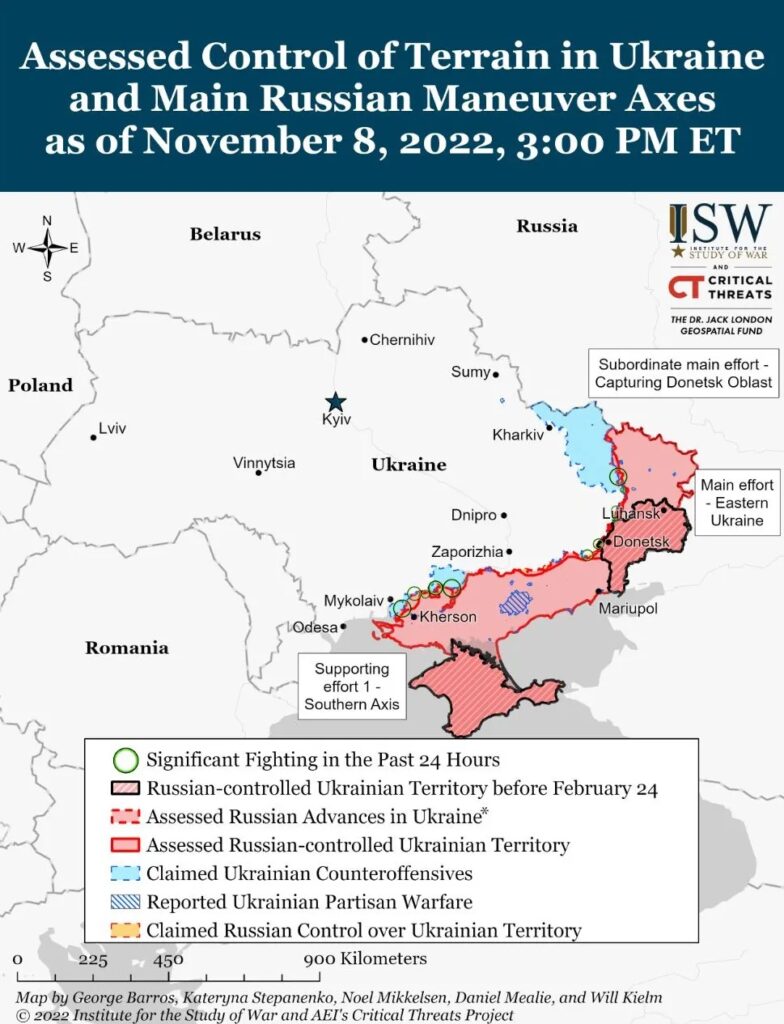Iranian Intervention
According to the Institute for the Study of War (ISW), Noer News, an Iranian state-run agency, recently reported on Russian National Security Council Secretary Nikolai Patrushev’s trip to Tehran on Nov. 8. Supposedly, Patrushev was on a mission to discuss the likely sale of Iranian missiles to Russia. They noted that the Secretary was slated to visit with various high-ranking Iranian government officials regarding future Russo-Iranian cooperation.
CNN has recently reported that for the first time, Iran has admitted to sending “a limited number” of drones to Russia before the war. They had previously denied doing so. Iran’s foreign minister, Hossein Amirabdollahian, told reporters in Iran:
“Some western countries have accused Iran of helping the war in Ukraine by providing drones and missiles to Russia. The part regarding missiles is completely wrong. The part about drones is correct; we did provide a limited number of drones to Russia in the months before the start of the war in Ukraine.”They’ve been known to have sent several hundred more after the war started, mainly of the Shahed-136 “kamikaze” variety that has been terrorizing the citizens of Kyiv in recent weeks.
The high-level meeting between Moscow and Tehran is reminiscent of 2015 when Islamic Revolutionary Guards Corps (IRGC) Quds Force Commander Qassem Soleimani visited Moscow to ask for Putin’s assistance with the war in Syria. The current visit coincides with reports that Iran is asking for Russia’s help in quelling numerous public protests there. However, it’s unknown whether this topic is on Patrushev’s agenda.
Gun Runners
Sky News has recently reported that Moscow flew an assortment of captured Stinger anti-aircraft missiles, Javelin anti-tank missiles, and British-made NLAW missiles (plus 140 million euros in cash) to Tehran in exchange for 160 Shahed-136 drones to be used in Ukraine. The transaction supposedly occurred in late August. The Ukrainian Resistance Center (URC) reports, through ISW, that Tehran has a network to transport many Iranian drones to Russian forces in Ukraine. Sometimes privately owned vehicles are utilized. Also, due to production quotas hindered by international sanctions, Russian armed forces continue to look to sources outside their nation to provide them with dual-use items such as night vision devices, small quad-copter surveillance drones, and computer chips. Many of these items are procured through Turkey and are purchased with cryptocurrency that cannot be tracked.

The Wagner Group Continues to Embellish Their Accomplishments
ISW tells of how the Russian press began reporting on how Wagner forces, along with elements of the 6th Cossack Regiment of the Luhansk People’s Republic (LPR), penetrated Ukrainian lines near Bilohorivka in the Luhansk Region. The next day, Russian news agencies walked back the involvement of the LPR troops, claiming that the Wagner Group was solely responsible for any gains. This is consistent with their history of taking full credit for Russian gains in the region to increase their reputation as a highly effective fighting force. They are expected to continue to utilize the Russian press as a propaganda tool in the future.
Kherson Oblast
Ukraine’s Southern Operational Command, according to ISW, is trying desperately to hold occupied positions in Kherson Oblast. Satellite images taken on Nov. 8 show Russian pillboxes in Hola Prystan on the east bank of the Dnipro River about five miles south of Kherson City. Russian bloggers on Telegram confirm the location of the hardened Russian positions and believe there are no indications these troops are prepared to withdraw.
Russian sources report that Ukrainian forces carried out largely unsuccessful attacks in various areas of Kherson Oblast on Tuesday. The state attacks were repelled near Pravdyne in western Kherson and Davydov Brid in northern Kherson Oblast. Russian airborne forces are said to be maintaining defensive positions throughout the Oblast. The reader must be reminded that all non-verified reports from Russian sources must be taken with a grain of salt.
 Eurasia Press & News
Eurasia Press & News


